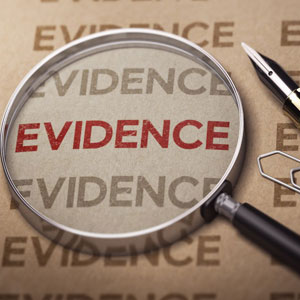
When you’ve suffered an injury, and you’re in the middle of a California personal injury claim, you may hear a lot of different legal references to evidence: a preponderance of evidence, clear and convincing evidence, the burden of proof. It may seem confusing, but there are such specific terms all referencing evidence because the requirements regarding evidence in this type of case are also quite precise.
A Preponderance of Evidence: Proving Your California Personal Injury Case
In many California personal injury cases, the plaintiff must prove their case with a preponderance of evidence. A preponderance of evidence means that the plaintiff’s claim is more likely true than not.
Clear and Convincing Evidence: Sometimes a Case May Require More
The court may require proof of a claim, fact, or element by clear and convincing evidence for the occasional civil case. Clear and convincing evidence may be necessary for California cases seeking punitive damages. In these cases, the plaintiff carries the burden of proving by clear and convincing evidence that the defendant was guilty of oppression, acted fraudulently, or with malice. Clear and convincing evidence requires a finding of high probability in comparison to something that is just more likely than not. Therefore the requirement to present clear and convincing evidence is a higher standard than the need for a preponderance of evidence. (However, it’s not as high a standard as “beyond a reasonable double,” which is the requirement for California criminal cases).
What is the Burden of Proof for Your California Personal Injury Case?
In California personal injury cases, the degree to which the plaintiff is required to prove their claim is true is referred to as the burden of proof. Most California personal injury cases have one of these two burdens of proof:
More likely than not/preponderance of evidence OR
Clear and convincing evidence
When Does the Burden of Proof Shift to the Defendant?
The defendant in some civil cases may sometimes have an “affirmative defense” to the claimed wrongful act. In these civil cases, when the plaintiff makes out a “prima facie” case for liability, the burden of proof shifts to the defendant. When the burden shifts, the defendant’s burden is to prove why their actions should be legally excused.
What Burden of Proof Do You Have to Meet in Your California Personal Injury Case?
The only way to determine which burden of proof is required for your California personal injury case is through research and in-depth knowledge of the laws applicable to your claim. In a California personal injury lawsuit, plaintiffs can have one or multiple claims or legal bases under which they can recover damages. Each different legal theory or claim may have a different standard of proof.
If you are injured and need to file a California personal injury claim, contact Moss Bollinger, Sherman Oaks, California personal injury attorney. He’s dedicated to protecting and asserting the rights of his clients. Call (310) 982-2291 today for a free consultation or contact us online.
Get Your Questions Answered. Call For Your
Free 30 Min Evaluation Today! (310) 982-2291